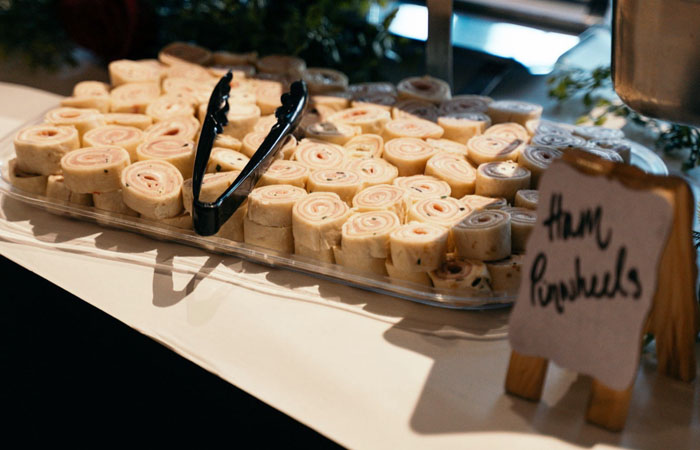How to Choose the Best Catering Maddington for Your Needs
Understanding the Art of Bakery Products: From Fresh Baked Breads to Tempting Pastries and Finger Foods
From the science behind the ideal loaf of bread, where fermentation and gluten advancement play critical roles, to the skill needed for developing split pastries, each aspect reveals an engaging story of workmanship. The adaptability of finger foods shows exactly how flavor and structure can be artfully incorporated to involve varied preference preferences.
The Science of Bread Making
At the heart of every loaf of bread lies a remarkable interplay of chemistry and biology. The procedure of bread making begins with the mix of flour, yeast, salt, and water-- each ingredient playing a crucial duty in the end product. Flour contains healthy proteins, mainly glutenin and gliadin, which, when combined with water, form gluten (Catering Maddington). This elastic network is essential for capturing gases generated during fermentation.
Yeast, a living organism, ferments the sugars present in the flour, generating co2 and alcohol at the same time. The co2 gas develops bubbles in the dough, causing it to increase and create a light texture. The temperature and humidity throughout fermentation significantly influence yeast activity and, as a result, the bread's taste and appearance.

Mastering Pastry Methods
Just how can one achieve the delicate balance of appearance and flavor that defines outstanding pastry? Mastering bread methods needs a deep understanding of active ingredients, techniques, and the science behind them. Essential to this craft is the selection of high-quality ingredients-- flour, butter, sugar, and eggs-- each playing an important duty in the last product's flavor and structure.
The strategy of lamination, which entails folding layers of dough and butter, produces the preferred flakiness in breads like croissants and puff bread. Precision in temperature is vital, as butter should continue to be cold to ensure optimum layers. Appropriate mixing approaches, such as the creaming method for cakes, ensure even consolidation of air and fat, resulting in a light and airy crumb.
Additionally, keeping the right humidity degrees throughout cooking can considerably influence the result, guaranteeing that breads increase correctly and achieve that golden-brown surface. Finally, the art of bread also demands persistence and method; each attempt boosts one's ability and understanding of the intricate equilibrium required to develop alluring pastries that delight the senses. Mastery in these techniques eventually distinguishes a proficient bread chef from an amateur.
Types of Finger Foods
The world of cooking delights expands past pastries to include a large variety of finger foods, which are commemorated for their convenience and versatility. These bite-sized deals with are best for social events, using a variety of tastes and textures that deal with diverse tastes.

On the sweeter side, bite-sized cupcakes and small tarts use a delightful surface to any type of dish, interesting those with a craving for sweets. Cheese and charcuterie boards serve as a sophisticated selection, allowing visitors to tailor their bites with an assortment of meats, nuts, cheeses, and fruits.
Taste Profiles in Baking
Baking is a detailed dance of flavor accounts that combines wonderful, mouthwatering, right here and umami notes to create an unified experience for the taste buds. Recognizing these profiles is important for bakers seeking to raise their creations.
Sweet taste commonly works as the foundation in baked items, with sugars, fruits, and natural sugar improving taste deepness. Active ingredients such as delicious chocolate and caramel present complex wonderful notes that can either dominate or match various other flavors. Alternatively, tasty components, typically located in pastries and breads, offer equilibrium and contrast. Active ingredients like natural herbs, cheeses, and spices can change a basic dough into a diverse flavor experience.
Umami, frequently ignored in cooking, plays a significant role in improving flavors. Components such as aged cheeses, fermented products, or even specific nuts add to a mouthwatering deepness that improves overall preference.
Additionally, the interplay of acidity from ingredients like buttermilk or citrus enthusiasm can lighten up tastes, using a revitalizing counterpoint to sweet taste. By attentively combining these flavor accounts, bakers can craft items that reverberate with diverse tastes, developing a remarkable cooking experience. Inevitably, understanding taste accounts is crucial to innovation worldwide of cooking.
Crucial Baking Tools and Ingredients
Recognizing flavor accounts in baking sets the stage for selecting the right devices and active ingredients that help with the production of remarkable baked products. A trusted collection of baking pans-- such as sheet frying pans, loaf pans, and cake pans-- is critical for achieving preferred forms and textures.
Flour serves as the backbone of many dishes; picking the appropriate type-- be it pastry, bread, or all-purpose flour-- can dramatically influence the outcome. Baking powder and baking soda are essential for producing lift in cakes and breads.
In addition, incorporating taste enhancers like vanilla remove, spices, and learn this here now citrus enthusiasm can boost your developments. By guaranteeing accessibility to these essential devices and active ingredients, bakers can confidently start their cooking trip, crafting a diverse variety of delightful baked products.
Conclusion
Mastery in bread making, pastry preparation, and finger food discussion exposes the elaborate partnerships in between processes and components. Catering Maddington. Discovering varied flavor accounts enriches the baking experience, while essential devices and components offer the structure for success.
Exactly how can one achieve the fragile balance of texture and flavor that defines remarkable bread? Basic to this craft is the option of high-quality ingredients-- flour, butter, sugar, and eggs-- each playing an essential role in the final item's taste and appearance.

Understanding flavor accounts in baking collections the stage for choosing the right devices and active ingredients that promote the production of extraordinary baked items. Checking out diverse flavor accounts improves the baking experience, while crucial tools and ingredients offer the structure for resource success.